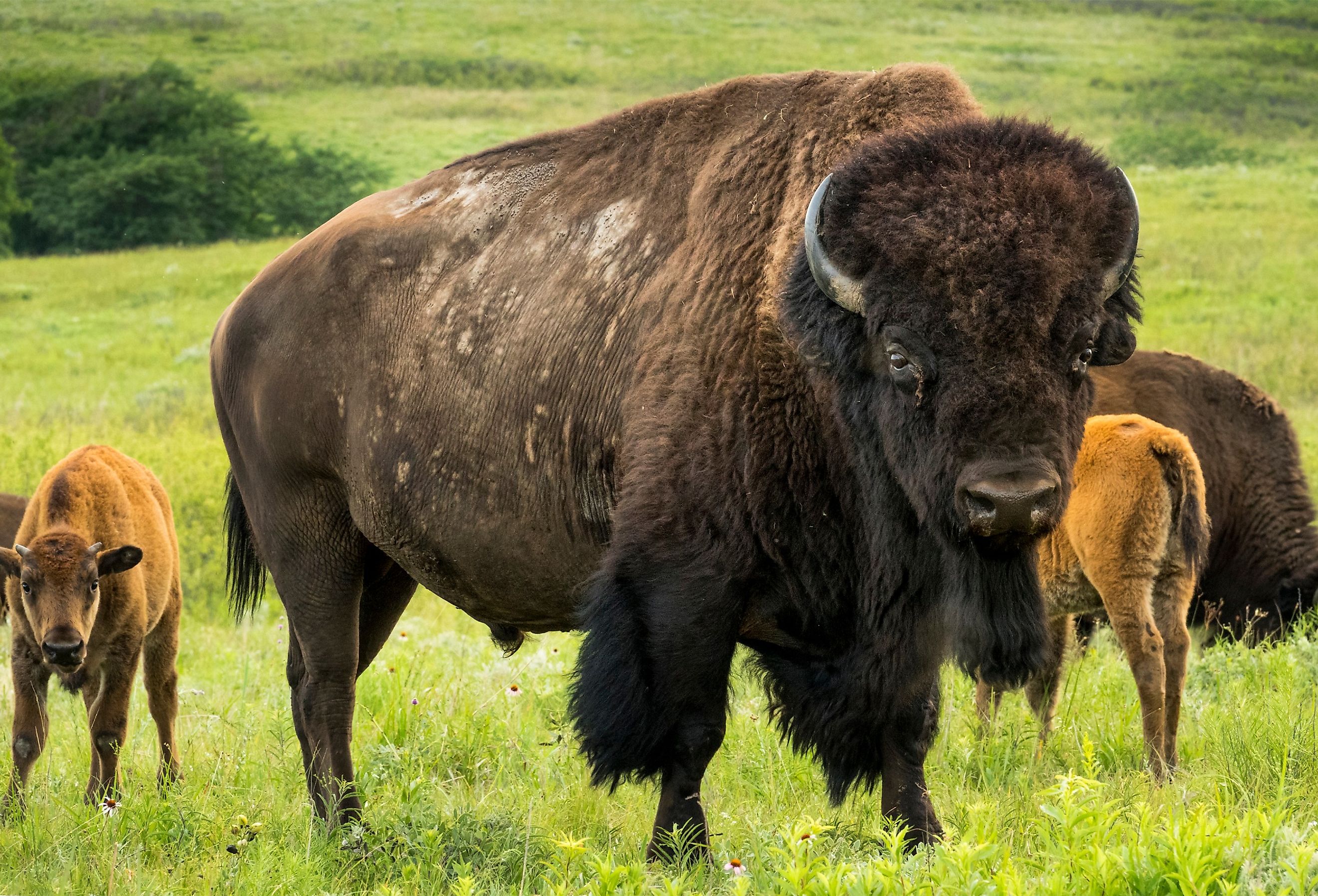
The 12 Deadliest Animals in Kansas
The Midwestern US state of Kansas is home to a colorful array of animals and plants, including 24,000 invertebrate and 798 vertebrate species. From the white-tailed deer to the elusive bobcats, organisms permeate the state's colorful landscape. Even the country's national mammal—the American Bison—thrives in the state's prairies! The diverse wildlife of the Sunflower State has its fair share of "cute and cuddly" animals but also has a collection of creatures that are dangerous when encountered or provoked. Avid wildlife enthusiasts traveling to Kansas may encounter these deadliest animals in Kansas during their outdoor adventures!
Common Snapping Turtle
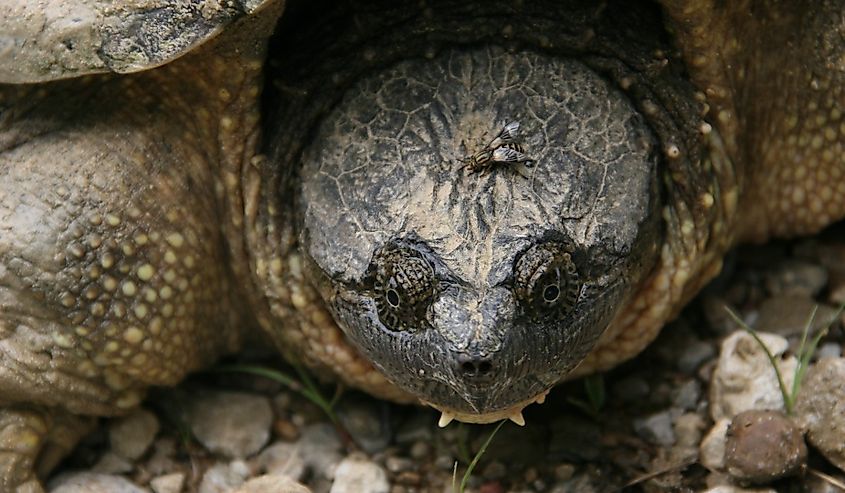
The snapping turtle (Chelydra serpentina) is a semiaquatic and omnivorous freshwater turtle species. These turtles don a tail that is as long as its shell with saw-toothed keels. They also have tubercles on their necks and legs, with a yellow-like color on its necks, legs, and tails.
Snapping turtles are largely distributed from Canada to the west coast of northern South America. In Kansas, they are present in the ephemeral streams (those that only flow for a short duration) of Western Kansas. They thrive in freshwater habitats, specifically environments with soft mud bottoms, submerged brush and logs, and an abundance of vegetation. They can also habituate in brackish water environments.
Snapping turtles are short-tempered and stand their ground when provoked. They can be vicious if removed from the water. As the name suggests, snapping turtles may inflict painful bites, albeit uncommonly.
They are not afraid of lunging strikes at their provoker, either. When disturbed, they may also emit a foul-smelling musk. However, these freshwater turtles will often leave people alone if they are unthreatened, as they prefer to avoid social encounters.
American Bison
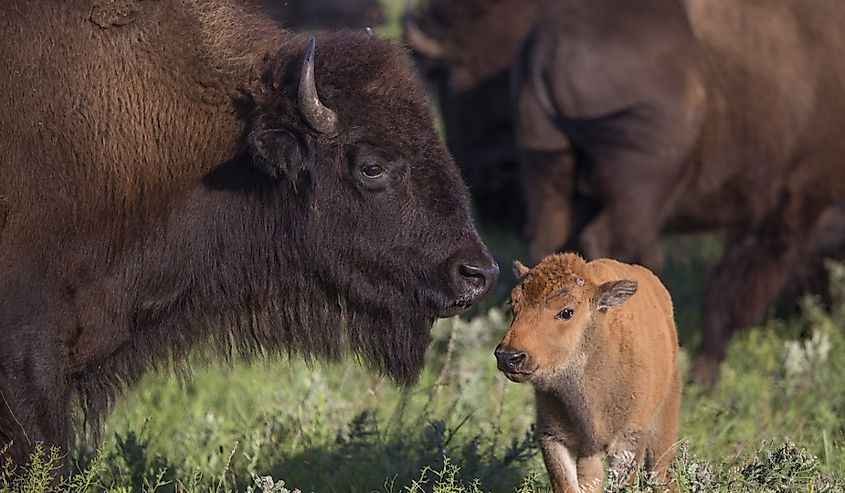
The American bison (Bison bison) is the national mammal of the US. American bison have roamed the North American continent since prehistoric times, are heavily intertwined with Indigenous communities, and are a symbol of the American West.
They are the largest mammal in North America, with males capable of weighing up to 2,000 lbs! Their bodies are a powerhouse, complete with a heavy head, a protruding shoulder hump, and covered with shaggy brown fur.
These massive land mammals are adaptable and capable of living in snowy habitats or dry environments. Yellowstone National Park is the only place in the US with bison living in the area, uninterrupted, since prehistoric times. Otherwise, state-managed conservation herds of American bison exist in numerous US states today, including Arizona, Minnesota, Missouri, Nebraska, South Dakota, Texas, Utah, Wisconsin, Wyoming, Alaska, and Kansas.
Kansas has the fifth-largest bison population in the country, and they are often found in ranches and state parks like the Maxwell Wildlife Refuge or the Tallgrass Prairie National Preserve.
At first glance, American bison appears tame. However, these mammals are unpredictably dangerous. Despite their large stature, bison can run up to 35 miles per hour. They can also spin fast, jump over objects (about 5 feet in height), and are good swimmers! The National Parks Service advises people to maintain a distance of at least 25 yards from bison.
Blacklegged or Deer Ticks
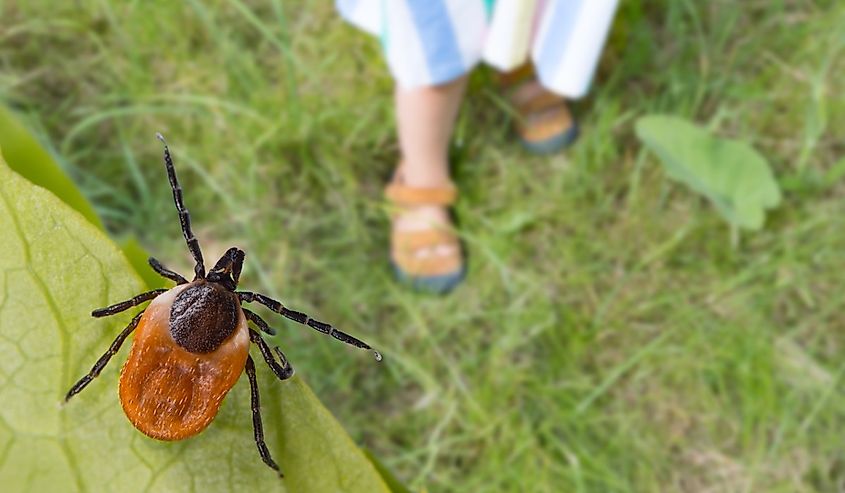
Ticks are slow-crawling, wingless parasites that are spread across the US, and four of these species are found in Kansas. Ticks in Kansas are usually from the Ixodidae family, which is known as "hard ticks." This family of ticks is known for its hardened dorsal shield and head that extends at the front of the body.
Feasting on animal and human blood, ticks are possible vectors of microbial pathogens, making their reputation deadly. Reportedly, black-legged or deer ticks (Ixodes scapularis) are said to be the primary species that transmit Lyme disease in Kansas, often found hiding within forested spaces in eastern Kansas. They may also be vectors of Anaplasma phagocytophilium, a bacterium that can cause anaplasmosis.
Lone Star Ticks
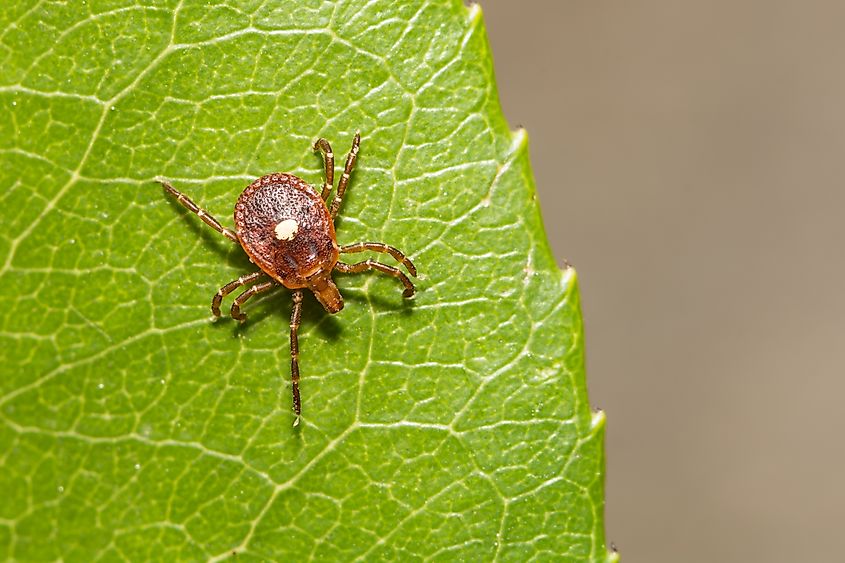
The lone star tick (Amblyomma americanum) is another species of tick found throughout Kansas, but it is most common in the eastern portion of the state. Its name is derived from the white dot seen on the back of the female tick. In addition to Lyme disease, lone star ticks can transmit diseases like human monocytic ehrlichiosis, Rocky Mountain spotted fever, and tularemia.
Prevent tick bites by avoiding areas of tall grass, weeds, or bushes and use insect repellent with DEET, permethrin, picaridin, oil of lemon eucalyptus, IR3535, or 2-undecanone when outdoors. If you find a tick attached to the skin, remove the insect immediately using forceps or tweezers. Slowly and with steady pressure, pull the tick straight out; do not twist it. Dispose of the tick by placing it in alcohol or sealing it in a container.
Kissing Bugs
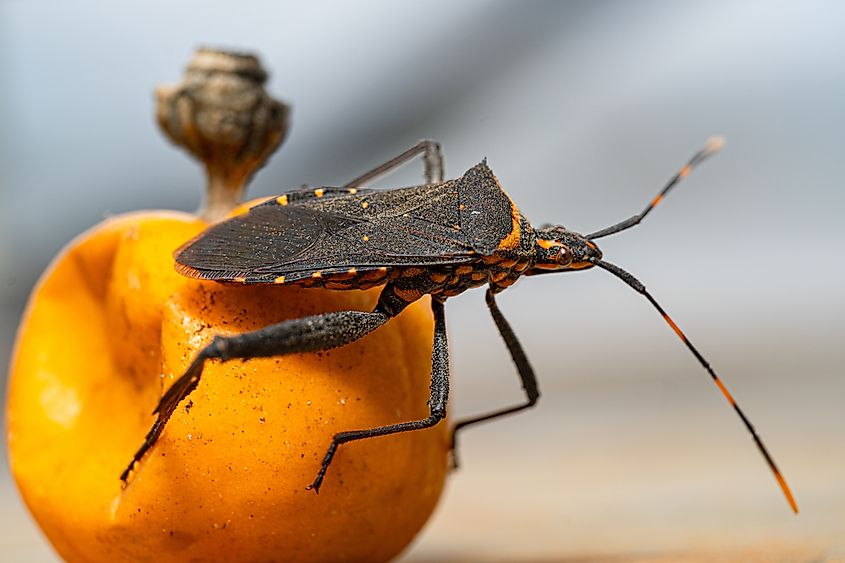
This insect got its name because it was initially believed that they often bite the face of its host, though it can also target any part of the victim's body. These pests are also referred to as cone-nose bugs or chinches. They are about a half to one inch long, and most species of these insects don a striped band with orange or red marks on the edge of their bodies.
Kissing bugs thrive in nests of rodents and other wildlife, but have also been known to live in barns and homes through the openings of beds, floors, walls, and furniture. About 11 species of kissing bugs can be found throughout the Americas and in 29 states. Kissing bugs have been found in the US since the mid-19th century.
These pesky bugs are typically active at night and feed on their host's blood. Kissing bugs may carry the parasite (Trypanosoma cruzi) that causes Chagas disease, an inflammatory and infectious disease that can cause heart or digestive issues if left untreated. It is estimated that about 50% of kissing bugs carry the disease, though the number of infected insects varies by location.
Individuals can prevent kissing bug infestation in their homes by sealing windows, keeping pets inside at night, maintaining a clean area around the house by removing trash, wood, and other debris, or devising pest management strategies with the help of a pest control company.
Velvet Ants
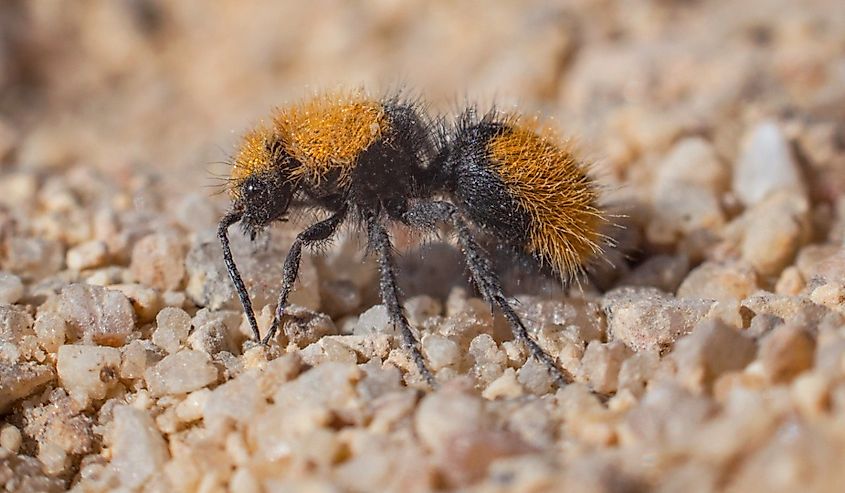
Scientifically known as the Dasymutilla occidentalis, the velvet ant is a special group of insects in the wasp family. Despite its name, this insect is not a true ant species! These solitary wasps are known for their furry bodies, which are vibrantly colored with orange and red hues.
Velvet ants live in dry, sunny, sandy, and open habitats such as fields, meadows, lawns, or forest edges. They may parasitize nesting bees and wasps. The velvet ant's range extends from Florida to Connecticut and Pennsylvania and towards the western edge of Texas into Colorado and Kansas.
Velvet ants are not aggressive, yet females will sting provokers if they are being held or stepped on. The sting of a velvet ant is excruciatingly more painful than a bee sting. Its sting is so painful that the wasp is referred to as the "cow killer!" While the venom is not very toxic, individuals ought to avoid handling velvet ants to prevent getting a jab of their painful sting.
Otherwise, individuals stung by a velvet ant should apply pain relievers or ice packs if needed. The site of the sting should also be properly cleaned, and medical attention should be sought immediately if a rash develops or if breathing difficulties ensue.
Copperhead Snake

Known as the Agkistrodon contortrix, the copperhead is the only uniquely banded snake in Kansas that lacks a rattle. Copperheads may vary in color, from a gray to light brown body with dark gray or brown crossbands.
Copperheads prefer to live in open and rocky woodlands, woodland edges, or meadows that are close to woodland environments, where they can camouflage with leaf litter. These snakes are bound to the eastern third of Kansas and are commonly found in Fort Riley and on the western edge of Flint Hills. Outside Kansas, in the US, the copperhead range spans from the Florida Panhandle toward the north of Massachusetts and towards the west to Nebraska.
Copperheads can strike their victim at any time they feel threatened. The snake's bite is painful and typically induces temporary tissue damage in the bite area. Fortunately, copperhead venom is rarely fatal to humans due to its low toxicity, but may still pose a risk to the elderly, young children, or individuals with health complications.
Massasauga Rattlesnake
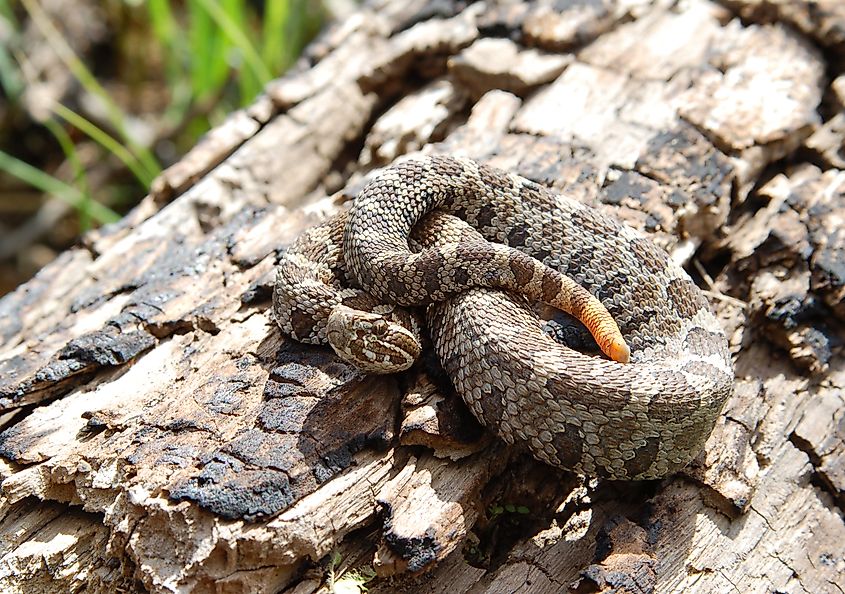
The massasauga (Sistrurus catenatus) is the smallest rattlesnake in Kansas! It belongs to a family of "pygmy" rattlesnakes due to its size. This rattlesnake has a light-brown body with rows of brown blotches and a prominent brown stripe around its eyes. Due to its size, its rattling is often difficult to hear and sounds similar to the buzz of a grasshopper.
The massasauga is found in the eastern three-quarters of Kansas and is common in Flint Hills and the Cheyenne Bottoms. It lives in a range of environments, including arid sagebrush prairies, open wetlands, and rocky prairie hillsides.
Fortunately, massasaugas are not aggressive and will only strike an individual or animal if it is directly disturbed. The venomous bite of a massasauga can be dangerous because of its high toxicity. Luckily, a bite from this venomous snake is uncommonly fatal, since the snake's small fangs only enable it to inject a small volume of venom into its victim.
Brown Recluse Spider
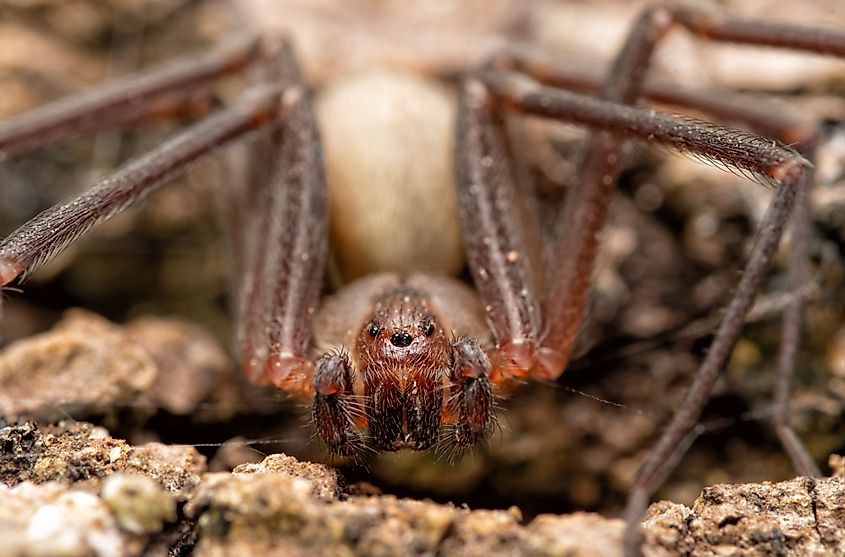
The brown recluse spider (Loxosceles reclusa) is also known as a fiddleback or violin spider. They are chocolate brown and have violin-shaped markings on their cephalothorax.
The brown recluse spiders are typically found in dry, cluttered, and undisturbed spaces with an abundance of insects (or other small organisms) for prey. They are often found in the South and Central US within 16 states, including Kansas.
Most bites from a brown recluse spider happen when its habitat of seldom-used clothes is disturbed, and they are provoked with counter pressure (such as being trapped against human skin when the clothing is being put on). Though a majority of reported bites from a brown recluse often cause little to no symptoms, a human reaction to a bite from a brown recluse spider can vary depending on the amount of venom injected in the victim and the victim's sensitivity to the spider's venom. Some victims may immediately feel a stinging and intense pain upon being bitten.
It is rare for a brown recluse spider bite to produce a large necrotic lesion (or a dermonecrotic lesion), which can transform the skin (around the bite area) black and require medical attention. Like other insect bites, bites from a brown recluse spider should be monitored carefully.
Prairie Rattlesnake
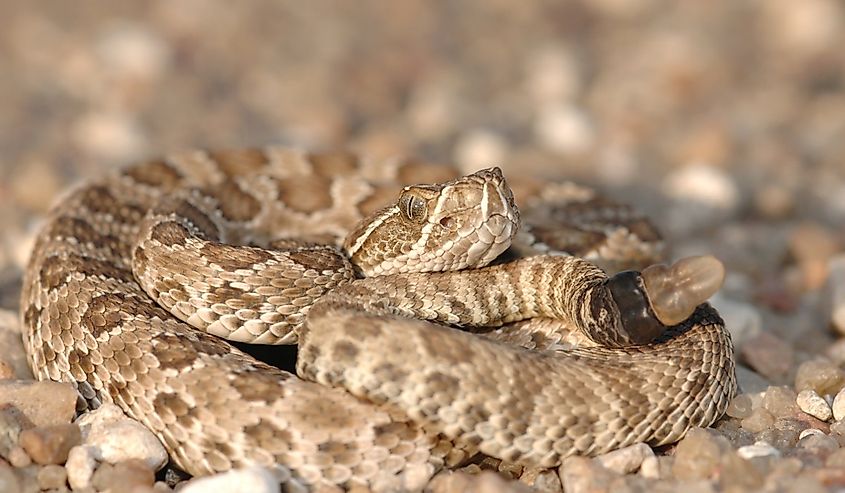
The prairie rattlesnake (Crotalus viridis) is a thermosensitive snake with a triangular head and dark blotches (or rings) spanning its body. These snakes are usually green in color, though they can also sport hues of brown or yellow across its body.
The prairie rattlesnake's range spans the Great Plains from Canada to Mexico. Specifically, in Kansas, these rattlesnakes are often found across the western part of the state, from Jewell to Barber Counties. Prairie rattlesnakes prefer rocky canyons and open prairie habitats with caves for small mammals. They are also present in agricultural areas.
Individuals can hear the rattles of prairie rattlesnakes when they are close. Fortunately, these snakes hardly present a threat to humans and will only strike if provoked. However, the venom from prairie rattlesnakes is hemotoxic and cytotoxic and can cause tissue damage around the bite area, so anti-venom is the only treatment.
Timber Rattlesnake
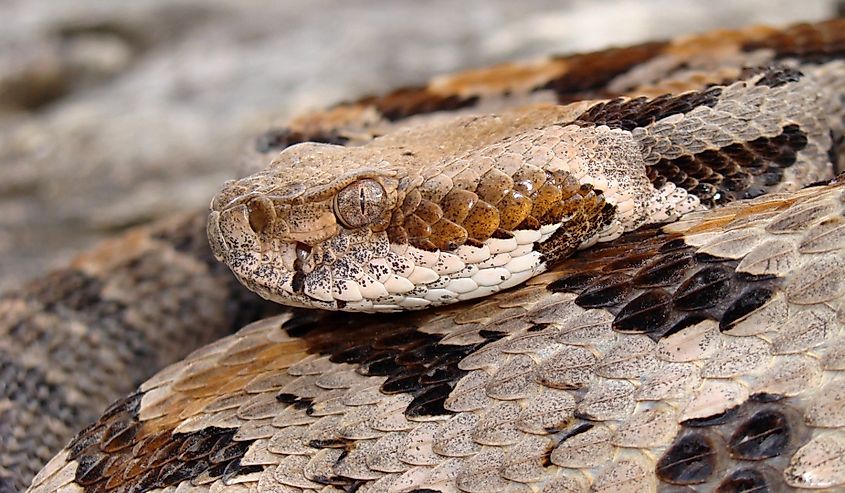
The timber rattlesnake (Crotalus horridus) is also referred to as the American viper, black rattlesnake, and canebrake. These snakes are skilled climbers and have even been found in trees over 80 feet high!
Timber rattlesnakes live in the eastern parts of the US, particularly in parts of Texas, Iowa, central Wisconsin, Georgia, West Virginia, Pennsylvania, and New England. In Kansas, these venomous snakes roam the eastern third of the state, specifically in the Riley and Geary Counties. They are the largest venomous snake in Kansas! These rattlesnakes prefer to live in areas that are heavily vegetated and in rocky outcrops on partially forested hillsides. During the summer or late spring, you may also find them in cultivated fields or open areas.
They are mild-mannered and prefer to avoid direct contact with humans. When confronted, they often remain motionless and quiet to avoid detection. They may also provide "warning rattles" to provokers for a prolonged period.
Black Widow Spider
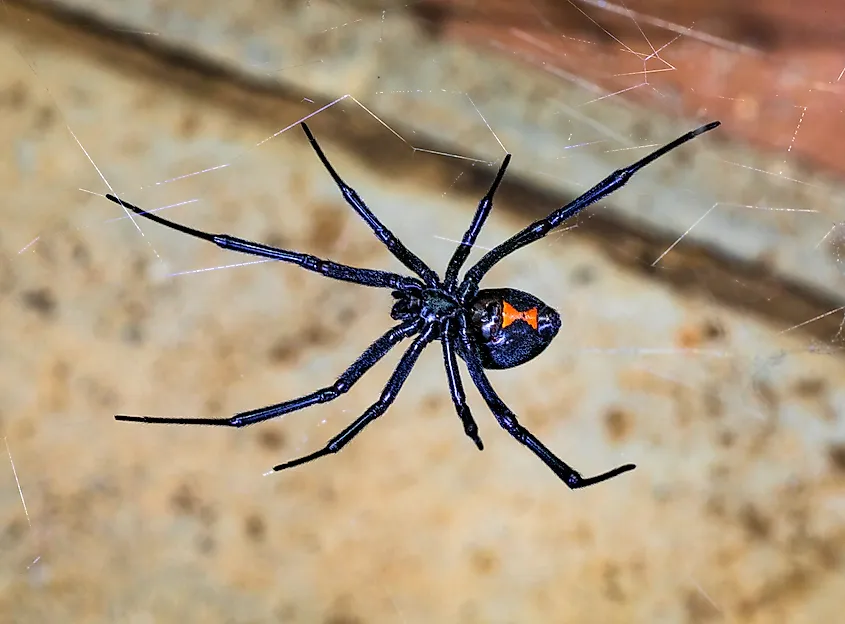
The black widow spider is famous for its jet-black, sphere-like abdomen. Many female black widow spiders have a red hourglass shape on their bodies. These insects are members of the cobweb spider family Theridiidae.
Three species of black widow spiders live in northern, southern, and western parts of Kansas. These reclusive and nocturnal spiders often set their nests in quiet and undisturbed outdoor environments, such as under rocks, around lawn debris or woodpiles, or within seldomly used clothing or living quarters.
Black widow spiders prefer to escape a threat rather than bite their provokers. However, they are not afraid to deliver a painful bite when threatened, especially when their living spaces are invaded or destroyed. Female black widows carry a venomous bite and will use it as a last-ditch effort to defend themselves.
A black widow spider bite is rarely fatal but may harbor a neurotoxic venom that causes severe muscle cramping, nausea, localized pain, vomiting, headaches, sweating, and trembling. In rare cases, these bites may induce tremors, convulsions, breathing difficulties, or suffocation.
Thousands of wildlife species call the Sunflower State home, thriving in the state's rugged landscape. Kansas also hosts many deadly animals, from unassuming bison roaming in the prairies to elegant black widow spiders habituating woody places. Luckily, many of these dangerous animals in Kansas prefer to keep their distance from humans. Still, it is always a good idea to take cautious measures during wildlife watching to avoid crossing paths with these dangerous Kansas animals.











